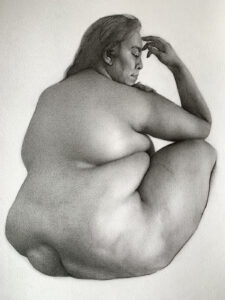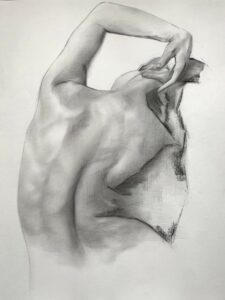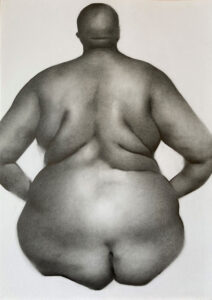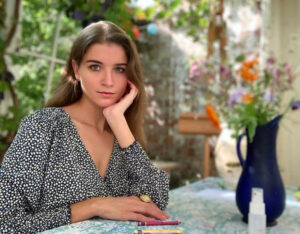Heloise O’Keeffe
Year of birth: 1992.
Where do you live: London.
www.heloiseokeeffe.com | Instagram
What initially drew you to the female form as your primary subject in your artwork?
Although I had been interested in the human form since I started art lessons at school, it wasn’t until I spent a bit of time living in Amsterdam and started taking life drawing lessons that I realised this was what I wanted to do, and this was the sort of artwork I wanted to explore and create. I had a brilliant teacher who encouraged me to not just document what I saw but to create expression and flare in the work I was producing.
I also had some of the most brilliant art museums and galleries at my fingertips and I spent a lot of time walking around and taking in works of artists I had never seen before. I was particularly inspired by an exhibition at the Van Gogh Museum called Easy Virtue, prostitution in French art, 1850-1910. It explored how prostitution became a central subject for male artists, like Picasso, Manet, Renoir, Degas and Toulouse-Lautrec in Paris at the time. It seemed obvious to me that these works would be centred around the male gaze, overly sexualised, voyeuristic and purely from a male perspective. It made me think how nothing much had changed in today’s society and it made me want be part of the narrative that was redefining how we saw women and women’s bodies and I was determined as a female artist to have a say in this.
 Heloise O’Keeffe | Eliana | 2024
Heloise O’Keeffe | Eliana | 2024
How did your time studying at Sarum Studio and LARA influence your artistic style?
I learnt so much during my time at Sarum Studio and LARA. My time studying was all about technique, practice and putting in the hours and I am extremely lucky to have had access to this training and to such brilliant teachers. It emphasised my love for drawing, documenting and representing the human form on paper or canvas and I found myself obsessing over accuracy and anatomy.
However, it took me a long time after I finished my training to find my voice as an artist. I knew I didn’t want to only create classical works and there were so many contemporary artists I was discovering and was being hugely inspired by.
Now being a lot more comfortable in the sort of work I am creating and the sort of artist I am becoming I always go back to my training as a base point for a lot of the work I create. The skills I learnt during my training will always be with me and I am hugely grateful for it.
Can you elaborate on the impact of artists like Jenny Saville, Lucian Freud, and Rembrandt on your work?
I first saw a print of one of Jenny Saville’s works when I was about twelve years old, and I instantly fell in love with it. I don’t think I had ever seen anything like it before. It was so raw, real and so different to any images I had seen of women’s bodies. I was so used to seeing airbrushed, altered images of women and was very aware as a 12-year-old on the cusp of being a teenager of what sort of woman society wanted me to be and look like.
As I became more and more interested in art and especially painting the female form Jenny Saville became a constant go to for inspiration. Not only for allowing women the space to explore the themes of body and identity in a much more real and empowering way but also because of the texture of her work and her painting techniques. The fleshy quality to her work is something I also see and love about the works of Rembrandt and Freud. These artists weren’t afraid to show human beings in their most vulnerable, frail and real moments.
To me this is extremely empowering as a female artist working with my subject. Exploring that raw, organic, sometimes crude and vulnerable side to being alive to me is what it truly means to be human, and I think sometimes we forget that. We are so obsessed with perfection, and unrealistic expectations we forget how beautiful something real can be.
 Heloise O’Keeffe | Annie II | 2022
Heloise O’Keeffe | Annie II | 2022
What challenges do you face when trying to redefine societal views of the female body through your art?
Oh, there are a few, but I’ll go for the first one that came to mind and something I have a love hate relationship with, social media. Instagram for example is all about visual beauty and perfection and showing very unreal but enticing snippets of people’s lives. I’ve used the platform as an artist because it’s so visual and can be a brilliant way to showcase a portfolio of work and introduce people to what you do. But it’s also the biggest social platform for promoting negative and unrealistic views and expectations of women. That’s not to say there aren’t some incredibly talented artists out there using the platform to inform and empower women, we just need more of them out there!
Your work has been exhibited across the UK and Europe. How has the reception of your work varied in different cultural contexts?
I have been fortunate enough to have exhibited work in some amazing places and have received some incredible, encouraging and motivating receptions of my work. It’s such a lovely feeling when someone understands your work and what you are trying to say, and it is certainly one of the things which keeps me motivated to keep working as an artist.
However, it is interesting being asked this question, because I certainly do see differences in how some countries receive certain artworks and artists.
London and Paris for example. In my experience, after exhibiting in both cities it was fascinating comparing the art scenes in both. My grandfather was half French and being brought up with a huge French cultural influence in my life, I was very aware of some of the differences growing up and I have to say I do see this slightly in the art world.
I personally find Paris slightly more open and liberal to the more daring works. They seem much more likely to celebrate the female form in its raw and true sense, whereas London maybe has a bit more of a commercial approach to this. This is just my experience though and both cities have amazing art scenes and it’s a privilege to have been part of both.
 Heloise O’Keeffe | Pencil Study of a Seated Woman | 2021
Heloise O’Keeffe | Pencil Study of a Seated Woman | 2021
Can you share any memorable reactions or feedback you’ve received from viewers of your work?
This is an interesting question because of the subject matter of my work. In a professional context, at galleries, and exhibition openings I have received such touching, inspiring and kind comments about my craft. However, on social media, from people who aren’t in the art world it’s a different story. I’m sad to say mostly from men, making comments, like “she’s not my cup of tea” … or “I don’t want to see that sort of woman on here”.
I’ve even had one collector who refused to pay me for a major piece of work unless I went for a drink with him, another telling me he could make my career if he took me for dinner, one sending me inappropriate messages, linking it back to my work as if I had somehow asked for it and another giving me unsolicited advice about the sort of work I should and shouldn’t be doing.
These sorts of comments and interactions used to make me nervous, doubt myself and question being an artist. Especially when you first start out and have limited avenues to go down, you can feel helpless, and it does knock your confidence. However now, it just spurs me on, and makes me even more determined to keep doing what I’m doing, to use my work as a tool to empower women and to change the narrative and redefine the way we see the female body. We obviously still have a very long way to go.
What advice would you give to emerging artists who are interested in exploring similar themes in their work?
Be yourself. I spent years after art school, trying to figure out what sort of artist other people wanted me to be and what sort of work other people wanted me to create. Not only was the work not very good but I wasn’t enjoying what I was doing. I think in some ways, given my subject matter I was nervous about doing the sort of work I wanted to do, because of the reception I might get, and I still have many more boundaries I want to push and many more things I want to say with my work. As soon as I began to create work that was authentic to me that’s when things really clicked in place. Believe in yourself and believe in your work.


Leave a Reply